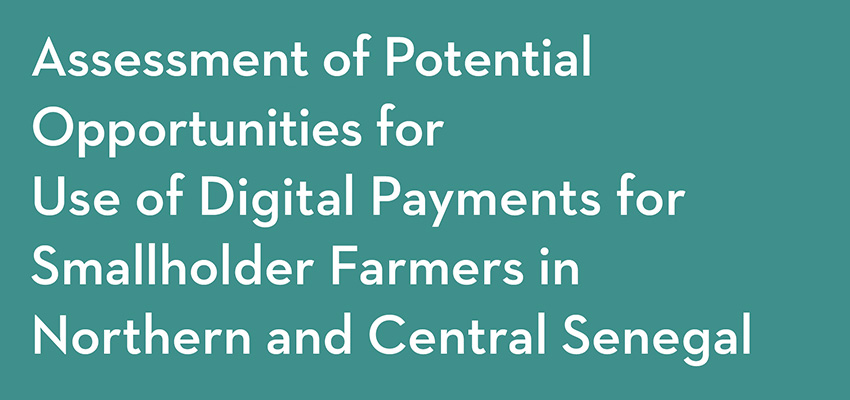
This research project, carried out in collaboration with the USAID’s Feed the Future Program, explored 1) how digital services can address the unmet financial needs of smallholder farmers; 2) the conditions under which smallholder farmers adopt digital financial services (DFS) to address these unmet needs; and 3) the characteristics that predict, incentivize, or are barriers to adoption of DFS by smallholder farmers.
Conclusions and recommendations
Through the research, the team identified several key findings for Senegal and specific recommendations. This section outlines the findings, recommendations, and the stakeholders who could potentially implement these recommendations.
First, financial inclusion is lower than digital inclusion, especially for women. For instance, 12% of the participants had a bank account and 44% had a financial account at a non-bank institution, while 100% owned a cell phone. Although phone ownership is high, this is not necessarily associated with high levels of financial inclusion. Providers, enablers, and conveners must be aware of this issue and develop programs and services that address the needs of the customers, particularly women.
In addition, the value proposition of DFS is not clear to potential customers, which is a key barrier to adoption. Thirty-six percent of non-users indicated that they feel that the services are not useful. In addition, 49% said they do not know how it works and this lack of knowledge was more apparent in the female respondents, especially older women. Thus, providers and enablers must acquire a better understanding of the financial lives of potential customers and develop programs that address their concerns.
Similarly, supply-side actors’ perceptions of the farmers’ needs were often inaccurate, which can mean that programs may not meet the needs of farmers. For instance, smallholder farmers preferred using an app to working with an agent and they preferred improved security to higher transaction success rate, which is the opposite of the supply-side actors’ perceptions. There were also misperceptions about the amount of time it takes to adopt DFS. Thus, providers, enablers, and conveners need to listen to the farmers, conduct customer research to uncover their needs and preferences, and co-creation solutions, so that they can create programs and services that target these individuals.
In addition, although delivery preferences do not appear to differ by geography, there are important differences between different groups like women, the elderly, and youth. For instance, youth were more open to joining new institutions as compared to older groups and men preferred individual accounts more than women. Thus, providers and enablers may need to conduct additional market research to understand the needs and preferences of each segment and differentiate solutions for each audience. This will be particularly important when providers are preparing to scale and target potential customers.
Preferences for delivery vary depending on the service the customer is trying access. When accessing insurance, customers preferred to have help through an agent or group. However, when it comes to transfers, customers preferred to use the phone and wanted lower transaction fees. Thus, there may be a need for providers to offer different delivery mechanisms depending
on the service.
Below is a review of the initial research questions and how they were addressed:
- Research question 1 (how can DFS address unmet financial needs of SHFs): The analysis identified that, for instance, digitizing agricultural subsidies or payments does seem to be a way to incorporate DFS into farmers’ lives in a way that they find valuable (Figure 19).
- Research question 2 (conditions for DFS adoption): Of the non-DFS users among the SHF sample in Senegal, nearly half said that not understanding how DFS works was a barrier to their adoption (see Figure 12). It follows that efforts to improve farmers' understanding and comfort with DFS—as both a technology and a service—would increase their likelihood of using DFS (see Figure 13). Further, 54% of SHFs in the sample began using DFS after having a historical relationship with the provider, and 72% started using mobile money because it was necessary to receive a digital transfer from someone. Taken together, this suggests that both push and pull strategies for promoting DFS among SHFs could be feasible: by requiring its use in order to receive monetary benefits (push), or by establishing an institutional relationship that can then be harnessed to leverage SHFs' DFS adoption through a known and ostensibly trustworthy provider (pull).
- Research question 3 (characteristics that matter for DFS adoption): the conjoint research findings specifically addressed this question and demonstrated not only how service delivery preferences for DFS can vary by various SHF sub-groups, but also how these preferences may not align with the perceptions of supply-side actors.
Through this work, additional questions arose:
- “Why” follow-ups to some of the findings, such as: 1) Why did Senegalese SHFs prefer digitizing agricultural subsidies over other agricultural financial services? 2) Why were the conjoint preferences for those who wanted to digitize agricultural insurance markedly different from the preferences of those wanting to digitize other agricultural financial services? and 3) What explains the supply-side misperception? (Are they drawing from a few select experiences and generalizing? Is their information outdated? Are SHFs telling them one thing and doing another thing)
- “How” questions, such as: 1) How can the value proposition for DFS be made clearer to SHFs? or 2) How can trust be built among SHFs and financial institutions?
- Further investigating some of the gender and age findings in an effort to understand how to best target these and other minority or disadvantaged population segments.
Additional results will be shared in subsequent publications.
Contact
Kendra Leith, MIT D-Lab Associate Director for Research

